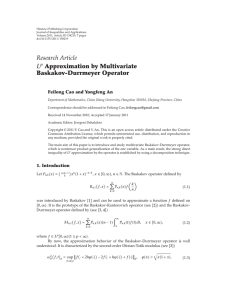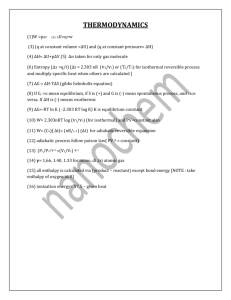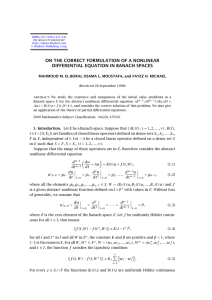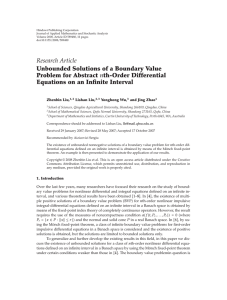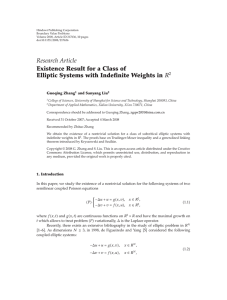Document 10942607
advertisement
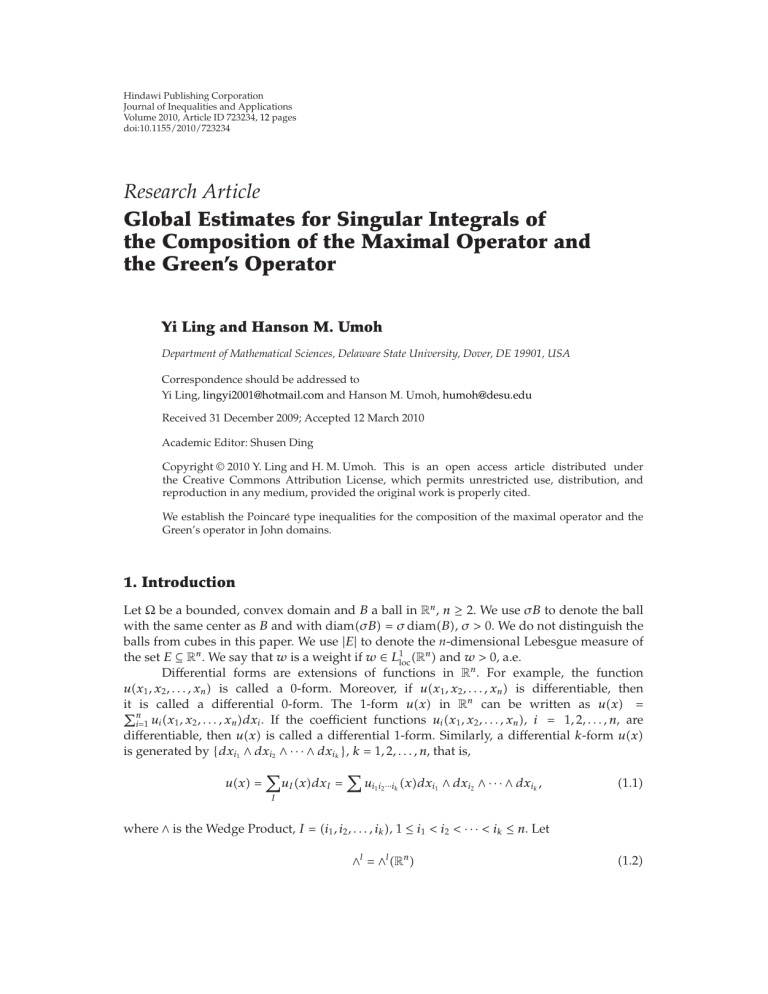
Hindawi Publishing Corporation
Journal of Inequalities and Applications
Volume 2010, Article ID 723234, 12 pages
doi:10.1155/2010/723234
Research Article
Global Estimates for Singular Integrals of
the Composition of the Maximal Operator and
the Green’s Operator
Yi Ling and Hanson M. Umoh
Department of Mathematical Sciences, Delaware State University, Dover, DE 19901, USA
Correspondence should be addressed to
Yi Ling, lingyi2001@hotmail.com and Hanson M. Umoh, humoh@desu.edu
Received 31 December 2009; Accepted 12 March 2010
Academic Editor: Shusen Ding
Copyright q 2010 Y. Ling and H. M. Umoh. This is an open access article distributed under
the Creative Commons Attribution License, which permits unrestricted use, distribution, and
reproduction in any medium, provided the original work is properly cited.
We establish the Poincaré type inequalities for the composition of the maximal operator and the
Green’s operator in John domains.
1. Introduction
Let Ω be a bounded, convex domain and B a ball in Rn , n ≥ 2. We use σB to denote the ball
with the same center as B and with diamσB σ diamB, σ > 0. We do not distinguish the
balls from cubes in this paper. We use |E| to denote the n-dimensional Lebesgue measure of
the set E ⊆ Rn . We say that w is a weight if w ∈ L1loc Rn and w > 0, a.e.
Differential forms are extensions of functions in Rn . For example, the function
ux1 , x2 , . . . , xn is called a 0-form. Moreover, if ux1 , x2 , . . . , xn is differentiable, then
it is called a differential 0-form. The 1-form ux in Rn can be written as ux n
i1 ui x1 , x2 , . . . , xn dxi . If the coefficient functions ui x1 , x2 , . . . , xn , i 1, 2, . . . , n, are
differentiable, then ux is called a differential 1-form. Similarly, a differential k-form ux
is generated by {dxi1 ∧ dxi2 ∧ · · · ∧ dxik }, k 1, 2, . . . , n, that is,
ux uI xdxI ui1 i2 ···ik xdxi1 ∧ dxi2 ∧ · · · ∧ dxik ,
1.1
I
where ∧ is the Wedge Product, I i1 , i2 , . . . , ik , 1 ≤ i1 < i2 < · · · < ik ≤ n. Let
∧l ∧l Rn 1.2
2
Journal of Inequalities and Applications
be the set of all l-forms in Rn ,
D Ω, ∧l
1.3
the space of all differential l-forms on Ω, and
Lp Ω, ∧l
1.4
the l-forms ux I uI xdxI on Ω satisfying Ω |uI |p dx < ∞ for all ordered l-tuples I,
l 1, 2, . . . , n. We denote the exterior derivative by
d : D Ω, ∧l −→ D Ω, ∧l1
1.5
for l 0, 1, . . . , n − 1, and define the Hodge star operator
1.6
: ∧k −→ ∧n−k
as follows. If u uI dxI , i1 < i2 < · · · < ik is a differential k-form, then
u −1
I
1.7
uI dxJ ,
where I i1 , i2 , . . . , ik , J {1, 2, . . . , n} − I, and
codifferential operator
I kk 1/2 d : D Ω, ∧l1 −→ D Ω, ∧l
k
j1 ij .
The Hodge
1.8
is given by d −1nl1 d on D Ω, ∧l1 , l 0, 1, . . . , n − 1. We write
u
s,Ω
Ω
|u|s dx
1/s
.
1.9
The differential forms can be used to describe various systems of PDEs and to express
different geometric structures on manifolds. For instance, some kinds of differential forms are
often utilized in studying deformations of elastic bodies, the related extrema for variational
integrals, and certain geometric invariance. Differential forms have become invaluable tools
for many fields of sciences and engineering; see 1, 2 for more details.
In this paper, we will focus on a class of differential forms satisfying the well-known
nonhomogeneous A-harmonic equation
d Ax, du Bx, du,
1.10
Journal of Inequalities and Applications
3
where A : Ω × ∧l Rn → ∧l Rn and B : Ω × ∧l Rn → ∧l−1 Rn satisfy the conditions
|Ax, ξ| ≤ a|ξ|p−1 ,
Ax, ξ · ξ ≥ |ξ|p ,
|Bx, ξ| ≤ b|ξ|p−1
1.11
for almost every x ∈ Ω and all ξ ∈ ∧l Rn . Here a, b > 0 are constants and 1 < p < ∞ is a fixed
exponent associated with 1.10. If the operator B 0, 1.10 becomes d Ax, du 0, which
is called the homogeneous A-harmonic equation. A solution to 1.10 is an element of the
1,p
1,p
Sobolev space Wloc Ω, ∧l−1 such that Ω Ax, du·dϕBx, du·ϕ 0 for all ϕ ∈ Wloc Ω, ∧l−1 with compact support. Let A : Ω × ∧l Rn → ∧l Rn be defined by Ax, ξ ξ|ξ|p−2 with
p > 1. Then, A satisfies the required conditions and d Ax, du 0 becomes the p-harmonic
equation
d du|du|p−2 0
1.12
for differential forms. If u is a function 0-form, 1.12 reduces to the usual p-harmonic
equation div∇u|∇u|p−2 0 for functions. A remarkable progress has been made recently
in the study of different versions of the harmonic equations; see 3 for more details.
Let C∞ Ω, ∧l be the space of smooth l-forms on Ω and
W Ω, ∧l u ∈ L1loc Ω, ∧l : u has generalized gradient .
1.13
The harmonic l-fields are defined by
H Ω, ∧l u ∈ W Ω, ∧l : du d u 0, u ∈ Lp for some 1 < p < ∞ .
1.14
The orthogonal complement of H in L1 is defined by
H⊥ u ∈ L1 :< u, h > 0 for all h ∈ H .
1.15
Then, the Green’s operator G is defined as
G : C∞ Ω, ∧l −→ H⊥ ∩ C∞ Ω, ∧l
1.16
by assigning Gu to be the unique element of H⊥ ∩ C∞ Ω, ∧l satisfying Poisson’s equation
ΔGu u − Hu, where H is the harmonic projection operator that maps C∞ Ω, ∧l onto H
so that Hu is the harmonic part of u. See 4 for more properties of these operators.
For any locally Ls -integrable form uy, the Hardy-Littlewood maximal operator Ms
is defined by
Ms u sup
r>0
1
|Bx, r|
Bx,r
s
u y dy
1/s
,
1.17
4
Journal of Inequalities and Applications
where Bx, r is the ball of radius r, centered at x, 1 ≤ s < ∞. We write Mu M1 u if s 1.
Similarly, for a locally Ls -integrable form uy, we define the sharp maximal operator M#s by
M#s u
sup
r>0
1
|Bx, r|
s
u y − uBx,r dy
1/s
,
1.18
Bx,r
where the l-form uB ∈ D B, ∧l is defined by
⎧
⎨|B|−1 uydy,
uB B
⎩
dT u,
l 0,
l 1, 2, . . . , n
1.19
for all u ∈ Lp B, ∧l , 1 ≤ p < ∞, and T is the homotopy operator which can be found in 3 .
Also, from 5 , we know that both Ms u and M#s u are Ls -integrable 0-form.
Differential forms, the Green’s operator, and maximal operators are widely used not
only in analysis and partial differential equations, but also in physics; see 2–4, 6–9 . Also, in
real applications, we often need to estimate the integrals with singular factors. For
example,
when calculating an electric field, we will deal with the integral Er 1/4π0 D ρxr −
x/ r − x 3 dx, where ρx is a charge density and x is the integral variable. The integral
is singular if r ∈ D. When we consider the integral of the vector field F ∇f, we have
to deal with the singular integral if the potential function f contains a singular factor, such
as the potential energy in physics. It is clear that the singular integrals are more interesting
to us because of their wide applications in different fields of mathematics and physics. In
recent paper 10 , Ding and Liu investigated singular integrals for the composition of the
homotopy operator T and the projection operator H and established some inequalities for
these composite operators with singular factors. In paper 11 , they keep working on the
same topic and derive global estimates for the singular integrals of these composite operators
in δ-John domains. The purpose of this paper is to estimate the Poincaré type inequalities for
the composition of the maximal operator and the Green’s operator over the δ-John domain.
2. Definitions and Lemmas
We first introduce the following definition and lemmas that will be used in this paper.
Definition 2.1. A proper subdomain Ω ⊂ Rn is called a δ-John domain, δ > 0, if there exists a
point x0 ∈ Ω which can be joined with any other point x ∈ Ω by a continuous curve γ ⊂ Ω so
that
dξ, ∂Ω ≥ δ|x − ξ|
for each ξ ∈ γ. Here dξ, ∂Ω is the Euclidean distance between ξ and ∂Ω.
2.1
Journal of Inequalities and Applications
5
Lemma 2.2 see 12 . Let φ be a strictly increasing convex function on 0, ∞ with φ0 0 and
D a domain in Rn . Assume that u is a function in D such that φ|u| ∈ L1 D, μ and μ{x ∈ D :
|u − c| > 0} > 0 for any constant c, where μ is a Radon measure defined by dμx wxdx for a
weight wx. Then, one has
φ
D
a
2
dμ ≤
u − uD,μ
φa|u|dμ
2.2
D
for any positive constant a, where uD,μ 1/μD
D
udμ.
Lemma 2.3 see 13 . Each Ω has a modified Whitney cover of cubes V {Qi } such that
Qi Ω,
Qi ∈V
i
χ√5/4Q ≤ NχΩ
i
2.3
and some N > 1, and if Qi ∩ Qj /
∅, then there exists a cube R (this cube need not be a member of V) in
Qi ∩ Qj such that Qi ∪ Qj ⊂ NR. Moreover, if Ω is δ-John, then there is a distinguished cube Q0 ∈ V
which can be connected with every cube Q ∈ V by a chain of cubes Q0 Qj0 , Qj1 , . . . , Qjk Q from
V and such that Q ⊂ ρQji , i 0, 1, 2, . . . , k, for some ρ ρn, δ.
Lemma 2.4 see 14 . Let u be a smooth differential form satisfying 1.10 in a domain D, σ > 10 <
s, and t < ∞. Then, there exists a constant C, independent of u, such that
u
s,B
≤ C|B|t−s/st u
2.4
t,σB
for all balls B with σB ⊂ D, where σ > 1 is a constant.
Lemma 2.5 see 5 . Let Ms be the Hardy-Littlewood maximal operator defined in 1.17, G the
Green’s operator, and u ∈ Lt Ω, ∧l , l 1, 2, 3, . . . , n, 1 ≤ s < t < ∞, a smooth differential form in a
bounded domain Ω. Then,
Ms Gu
t,Ω
≤C u
2.5
t,Ω
for some constant C, independent of u.
Lemma 2.6 see 5 . Let u ∈ Ls Ω, ∧l , l 1, 2, 3, . . . , n, 1 ≤ s < ∞, be a smooth differential form
in a bounded domain Ω, M#s the sharp maximal operator defined in 1.18, and G the Green’s operator.
Then,
#
Ms Gu
s,Ω
≤ C|Ω|1/s u
s,Ω
2.6
for some constant C, independent of u.
Lemma 2.7. Let u ∈ Ltloc Ω, ∧l , l 1, 2, . . . , n, be a smooth differential form satisfying the Aharmonic equation 1.10 in convex domain Ω, G the Green’s operator, and Ms the Hardy-Littlewood
6
Journal of Inequalities and Applications
maximal operator defined in 1.17 with 1 < s < t < ∞. Then, there exists a constant Cn, t, α, λ, ρ,
independent of u, such that
1/t
1
dx
|Ms Gu|
dx, ∂Ωα
B
t
≤ C n, t, α, λ, ρ |B|
γ
|u|
ρB
1/t
1
t
|x − xB |λ
dx
2.7
for all balls B with ρB ⊂ Ω and any real number α and λ with α > λ ≥ 0 and γ λ − α/nt, where
xB is the center of the ball and ρ > 1 is a constant.
Proof. Let ε ∈ 0, 1 be small enough such that εn < α − λ and B any ball with B ⊂ Ω, center xB
and radius rB . Taking k t/1 − ε, we see that k > t. Note that 1/t 1/k k − t/kt; using
Hölder’s inequality, we obtain
|Ms Gu|t
B
⎛
⎝
1
dx
dx, ∂Ωα
1/t
|Ms Gu|
⎞1/t
t
1
dx⎠
dx, ∂Ωα/t
⎛
1/k
k
⎝
≤
|Ms Gu| dx
B
B
≤ Ms Gu
1
k,B
dx, ∂Ω−αβ dx
2.8
dx⎠
dx, ∂Ωα/t
B
⎞k−t/kt
kt/k−t
1/βt
,
B
where β k/k − t. Since k > t > s, using Lemma 2.5, we get
Ms Gu
≤ C1 u
k,B
2.9
k,B .
Let m ntk/nt αk − λk, then 0 < m < t < k. Using Lemma 2.4, we have
u
k,B
≤ C2 |B|m−k/mk u
2.10
m,ρB ,
where ρ > 1 is a constant and ρB ⊂ Ω. By Hölder’s inequality with 1/m 1/t t − m/mt
again, we find
u
m,ρB
−λ/t
|u||x − xB |
|x − xB |
ρB
≤
−λ/t
|u||x − xB |
t
ρB
t
≤
−λ
λ/t
m
dx
1/t |x − xB |
dx
λ/t
mt/t−m
ρB
1/t |x − xB |
|u| |x − xB | dx
ρB
1/m
ρB
t−m/mt
2.11
dx
t−m/mt
mλ/t−m
dx
.
Journal of Inequalities and Applications
7
Note that dx, ∂Ω ≥ ρ − 1rB for all x ∈ B, it follows that
−αβ
ρ − 1 rB
.
dx, ∂Ω−αβ ≤
2.12
Hence, we have
dx, ∂Ω−αβ dx
1/βt
≤
−α/t 1/βt
ρ − 1 rB
|B|
2.13
B
C3 rB −α/t
|B|
1/βt
.
Now, by the elementary integral calculation, we obtain
t−m/mt
mλ/t−m
|x − xB |
dx
λ/tnt−m/mt
≤ C4 ρrB
.
2.14
ρB
Substituting 2.9–2.14 into 2.8, we obtain
|Ms Gu|t
B
< C5 rB 1/t
1
dx
dx, ∂Ωα
−α/tλ/tnt−m/mt
1/t
|B|
1/βtm−k/mk
−λ
t
|u| |x − xB | dx
ρB
1/t
C5 rB n/k−n/t
|B|
1/t−1/kλ−α/nt
−λ
t
|u| |x − xB | dx
ρB
1/t
C6 |B|
1/k−1/t
|B|
1/t−1/kλ−α/nt
|u| |x − xB | dx
ρB
C6 |B|
λ−α/nt
1/t
−λ
t
|u| |x − xB | dx
ρB
2.15
−λ
t
C n, t, α, λ, ρ |B|
1/t
γ
t
−λ
|u| |x − xB | dx
.
ρB
We have completed the proof.
Similarly, by Lemma 2.6, we can prove the following lemma.
Lemma 2.8. Let u ∈ Lsloc Ω, ∧l , 1 < s < ∞, l 1, 2, . . . , n, be a smooth differential form satisfying
the A-harmonic equation 1.10 in convex domain Ω, M#s the sharp maximal operator defined in
1.18, and G Green’s operator. Then, there exists a constant Cn, s, α, λ, ρ, independent of u, such
that
B
M#s Gu
s
1
dx
dx, ∂Ωα
1/s
≤ C n, s, α, λ, ρ |B|
γ
|u|
ρB
s
1
|x − xB |λ
1/s
dx
2.16
8
Journal of Inequalities and Applications
for all balls B with ρB ⊂ Ω and any real number α and λ with α > λ ≥ 0 and γ 1/s − λ − α/ns,
where xB is the center of the ball and ρ > 1 is a constant.
3. Main Results
Theorem 3.1. Let u ∈ Ltloc Ω, ∧l , l 1, 2, . . . , n, be a smooth differential form satisfying the Aharmonic equation 1.10, G Green’s operator, and Ms the Hardy-Littlewood maximal operator defined
in 1.17 with 1 < s < t < ∞. Then, there exists a constant Cn, ρ, t, α, λ, N, Q0 , Ω, independent of
u, such that
Ω
1/t
1
dx
dx, ∂Ωα
1/t
≤ C n, ρ, t, α, λ, N, Q0 , Ω
|u|t gxdx
Ms Gu − Ms GuQ0
t
3.1
Ω
for any bounded and convex δ-John domain Ω ⊂ Rn , where
gx χρQi
i
1
x − xQi
λ
3.2
,
ρ > 1 and α > λ ≥ 0 are constants, the fixed cube Q0 ⊂ Ω, the cubes Qi ⊂ Ω, the constant N > 1
appeared in Lemma 2.3, and xQi is the center of Qi .
Proof. First, we use Lemma 2.3 for the bounded and convex δ-John domain Ω. There is a
modified Whitney cover of cubes V {Qi } for Ω such that Ω ∪Qi , and Qi ∈V χ√5/4Q ≤
i
NχΩ for some N > 1. Moreover, there is a distinguished cube Q0 ∈ V which can be connected
with every cube Q ∈ V by a chain of cubes Q0 Qj0 , Qj1 , . . . , Qjk Q from V such that
Q ⊂ ρQji , i 0, 1, 2, . . . , k, for some ρ ρn, δ. Then, by the elementary inequality a bs ≤
2s |a|s |b|s , s ≥ 0, we have
Ω
Ms Gu − Ms GuQ0
⎛
≤⎝
∪Qi
t
1/t
1
α dx
dx, ∂Ω
1/t
t
Ms Gu − Ms GuQ0 dμ
t
t
2
Qi
Qi ∈V
Ms Gu − Ms GuQi dμ
t
2
t
Qi
Ms GuQi − Ms GuQ0 dμ
1/t
Journal of Inequalities and Applications
⎛⎛
⎞1/t
t
⎜
Ms Gu − Ms GuQi dμ⎠
≤ C1 t⎝⎝
9
Qi
Qi ∈V
⎛
⎝
Qi ∈V
Qi
Ms GuQi − Ms GuQ0
t
⎞1/t ⎞
⎟
dμ⎠ ⎠.
3.3
The first sum in 3.3 can be estimated by using Lemma 2.2 with ϕ xt , a 2, and
Lemma 2.7:
Qi ∈V
t
Qi
≤
Ms Gu − Ms GuQi dμ
Qi ∈V
2t |Ms Gu|t dμ
Qi
≤ C2 n, ρ, t, α, λ, Ω
|Qi |γt
|u|t dμi
ρQi
Qi ∈V
3.4
t
≤ C3 n, ρ, t, α, λ, Ω |Ω|γt
|u| dμi χρQi
Qi ∈V
Ω
C4 n, ρ, t, α, λ, N, Ω |Ω|γt
|u|t gxdx
Ω
C5 n, ρ, t, α, λ, N, Ω
|u|t gxdx,
Ω
where μx and μi x are the Radon measures defined by dμ 1/dx, ∂Ωα dx and dμi x 1/|x − xQi |λ dx, respectively.
To estimate the second sum in 3.3, we need to use the property of δ-John domain.
Fix a cube Qi ∈ V and let Q0 Qj0 , Qj1 , . . . , Qjk Qi be the chain in Lemma 2.3. Then we have
Ms GuQi − Ms GuQ0 ≤
k−1
i0
Ms GuQj − Ms GuQj
i
i1
.
3.5
The chain {Qji } also has property that for each i, i 0, 1, . . . , k − 1, Qji ∩ Qji1 / ∅. Thus, there
exists a cube Di such that Di ⊂ Qji ∩ Qji1 and Qji ∪ Qji1 ⊂ NDi , N > 1, so,
max Qji , Qji1
Qji ∩ Qji1
max Qji , Qji1
≤
≤ C6 N
|Di |
3.6
10
Journal of Inequalities and Applications
Note that
1
α dx
Q dx, ∂Ω
1
≥
α dx
Q diamΩ
μQ 3.7
C7 n, α, Ω|Q|,
where C7 n, α, Ω is a positive constant. By 3.6, 3.7, and Lemma 2.7, we have
t
Ms GuQj − Ms GuQj
i
i1
t
dx
1
Ms GuQj − Ms GuQj
i
i1
dx, ∂Ωα
μ Qji ∩ Qji1 Qji ∩Qji1
t
dx
C8 n, α, Ω
≤
Ms GuQj − Ms GuQj
i
i1
dx, ∂Ωα
Qji ∩ Qji1 Qji ∩Qji1
t
C8 n, α, ΩC6 N
≤
dμ
Ms GuQj − Ms GuQj
i
i1
max Qji , Qji1
Qji ∩Qji1
i1
t
1
Ms Gu − Ms GuQj dμ
≤ C9 n, t, α, N, Ω
k
Qjk
ki Qjk
γt
i1 Q
jk
≤ C10 n, ρ, t, α, λ, N, Ω
|u|t dμjk
ρQjk
ki Qjk
i1
γt−1
Qjk
C10 n, ρ, t, α, λ, N, Ω
|u|t dμjk
ρQjk
ki
≤ C11 n, ρ, t, α, λ, N, Ω
i1
|Ω|γt−1
ki
≤ C12 n, ρ, t, α, λ, N, Ω
Qi ∈V
Ω
Ω
C12 n, ρ, t, α, λ, N, Ω
Ω
|u|t dμjk χρQjk
|u|t dμi χρQi
|u|t gxdx.
Then, by 3.5, 3.8, and the elementary inequality |
obtain
Qi ∈V
Qi
M
i1 ti |
s
≤ Ms−1
M
i1
t
Ms GuQi − Ms GuQ0 dμ
≤ C13 n, ρ, t, α, λ, N, Ω
Qi ∈V
3.8
⎛
C13 n, ρ, t, α, λ, N, Ω ⎝
Ω
Qi
Qi ∈V
Qi
|u|t gxdx dμ
⎞
dμ⎠
Ω
|u|t gxdx
|ti |s , we finally
Journal of Inequalities and Applications
11
C13 n, ρ, t, α, λ, N, Ω
dμ
|u|t gxdx
Ω
C14 n, ρ, t, α, λ, N, Ω μΩ
|u|t gxdx
Ω
C15 n, ρ, t, α, λ, N, Ω
|u|t gxdx.
Ω
Ω
3.9
Substituting 3.4 and 3.9 in 3.3, we have completed the proof of Theorem 3.1.
Using the proof method for Theorem 3.1 and Lemma 2.8, we get the following
theorem.
Theorem 3.2. Let u ∈ Lsloc Ω, ∧l , l 1, 2, . . . , n, be a smooth differential form satisfying the Aharmonic equation 1.10, G Green’s operator, and M#s the sharp maximal operator defined in 1.18.
Then, there exists a constant Cn, ρ, s, α, λ, N, Q0 , Ω, independent of u, such that
Ω
1
dx
dx, ∂Ωα
≤ C n, ρ, s, α, λ, N, Q0 , Ω
|u|s gxdx
|M#s Gu − M#s GuQ0 |s
1/s
1/s
3.10
Ω
for any bounded and convex δ-John domain Ω ⊂ Rn , where
gx χρQi
i
1
x − xQi
λ
,
3.11
ρ > 1 and α > λ ≥ 0 are constants, the fixed cube Q0 ⊂ Ω, the cubes Qi ⊂ Ω, the constant N > 1
appeared in Lemma 2.3, and xQi is the center of Qi .
References
1 R. K. Sachs and H. H. Wu, General Relativity for Mathematicians, Springer, New York, NY, USA, 1977.
2 C. von Westenholz, Differential Forms in Mathematical Physics, North-Holland, Amsterdam, The
Netherlands, 1978.
3 R. P. Agarwal, S. Ding, and C. Nolder, Inequalities for Differential Forms, Springer, New York, NY, USA,
2009.
4 F. W. Warner, Foundations of Differentiable Manifolds and Lie Groups, vol. 94 of Graduate Texts in
Mathematics, Springer, New York, NY, USA, 1983.
5 S. Ding, “Norm estimates for the maximal operator and Green’s operator,” Dynamics of Continuous,
Discrete & Impulsive Systems A, vol. 16, supplement S1, pp. 72–78, 2009.
6 A. Banaszuk and J. Hauser, “Approximate feedback linearization: a homotopy operator approach,”
SIAM Journal on Control and Optimization, vol. 34, no. 5, pp. 1533–1554, 1996.
7 H. Cartan, Differential Forms, Houghton Mifflin, Boston, Mass, USA, 1970.
8 D. P. Knobles, “Projection operator method for solving coupled-mode equations: an application to
separating forward and backward scattered acoustic fields,” in Theoretical and Computational Acoustics,
pp. 221–232, World Scientific, River Edge, NJ, USA, 2004.
9 M. Okamura, “Evaluation of the time correlation function for the Kuramoto-Sivashinsky equation
with a projection operator method,” Progress of Theoretical Physics, vol. 116, no. 1, pp. 47–59, 2006.
12
Journal of Inequalities and Applications
10 S. Ding and B. Liu, “A singular integral of the composite operator,” Applied Mathematics Letters, vol.
22, no. 8, pp. 1271–1275, 2009.
11 S. Ding and B. Liu, “A singular integral of the composite operator,” Applied Mathematics Letters, vol.
22, no. 8, pp. 1271–1275, 2009.
12 S. Ding, “Lϕ μ-averaging domains and the quasi-hyperbolic metric,” Computers & Mathematics with
Applications, vol. 47, no. 10-11, pp. 1611–1618, 2004.
13 C. A. Nolder, “Hardy-Littlewood theorems for A-harmonic tensors,” Illinois Journal of Mathematics,
vol. 43, no. 4, pp. 613–632, 1999.
14 C. A. Nolder, “Global integrability theorems for A-harmonic tensors,” Journal of Mathematical Analysis
and Applications, vol. 247, no. 1, pp. 236–245, 2000.
